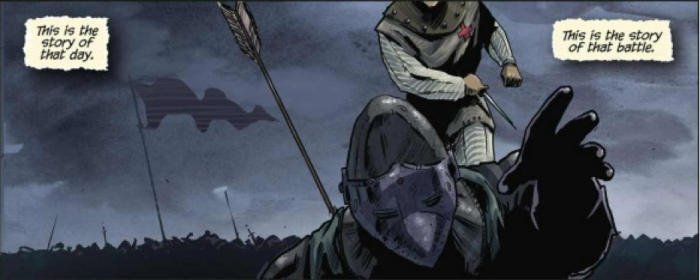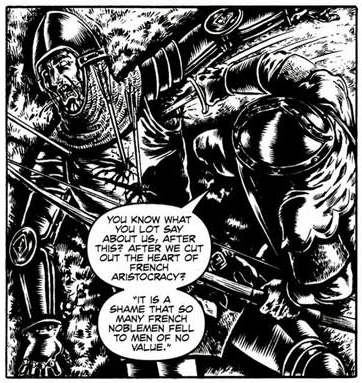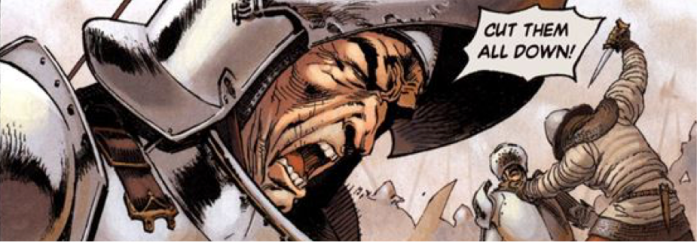A number of modern graphic novels depict medieval people, places and events, several of which are listed on the Medieval Comics blog. I have recently begun to consider how medieval warfare is portrayed in these works, in particular the depiction of conduct in war and chivalric behaviour. Many of these graphic novels provide a ‘soldier’s-eye-view’ of the battlefield and medieval warfare. Prominent in all of them is the practice of taking prisoners. Or not, as the case may be.

Agincourt 1415, by Will Gill (2015) [libapp.img.dl.ienglish.com]
As a code of conduct chivalry was enforced through peer pressure rather than hard-and-fast rules, and it was applied differently in different circumstances. Chivalry also took little note of the infantry, and the foot soldiers in turn recognised little benefit in showing mercy to those who would give them no quarter.
The image of the infantry exacting its revenge on the knightly class is explored explicitly in several examples. In Agincourt 1415, the English infantry pick over the remnants of the French cavalry charge. As the narrator comments:
Some we took prisoners…many we did not. You takes yer knife, you finds a gap in that fine armour of theirs. Under the arm. Into the groin…Killed ‘em quick like.

Crécy, by Warren Ellis and Raulo Cáceres (2007) [jlroberson.org]
See, peasants aren’t supposed to kill knights…Peasants should stand and do as we’re told…But we’re not taking prisoners or carrying wounded baggage around with us. So, we slide the long mercygiver up under the armpit into their heart.

Le Trône d’Argile, by Nicolas Jarry and France Richemond (2006-) [1.bp.blogspot.com]

On Dangerous Ground: Bannockburn 1314, by Fiona Watson, Conor Boyle, and Jim Campbell (2014) [i2.wp.com/downthetubes.net]
And yet knights were able to surrender at times. Chivalric conduct, exhibited by some, made this possible – possible enough that knights continued to fight in the hope, and perhaps even the expectation, that they would survive their experience.
Further Reading:
- On Dangerous Ground: Bannockburn 1314, by Fiona Watson and Conor Boyle (2014)
- Crécy, by Warren Ellis and Raulo Cáceres (2007)
- Agincourt 1415, by Will Gill and Graeme Howard (2015)
- Le Trone d’Argile, by Nicolas Jarry, France Richemond and Theo (2006-2015)
- Hawkwood: Mercenaire de la Guerre de Cent Ans, by Tommy Ohtsuka (2016-2017)
Dr Iain MacInnes is a lecturer and programme leader in Scottish History at the University of the Highlands and Islands. He has recently published his first monograph on the subject of Scotland’s Second War of Independence, 1332-1357.


